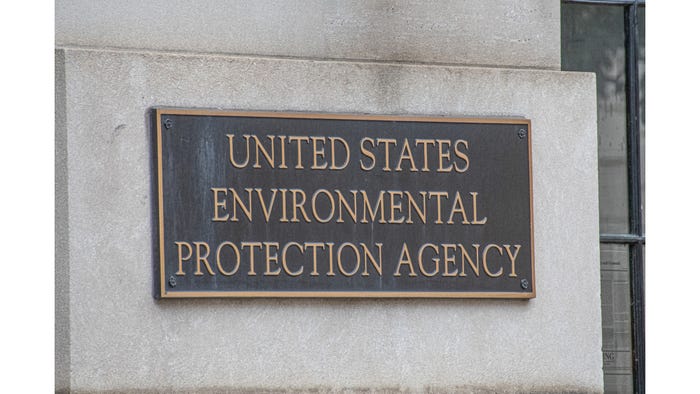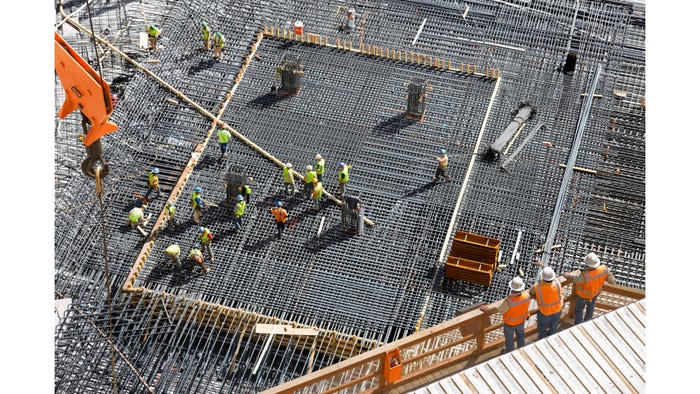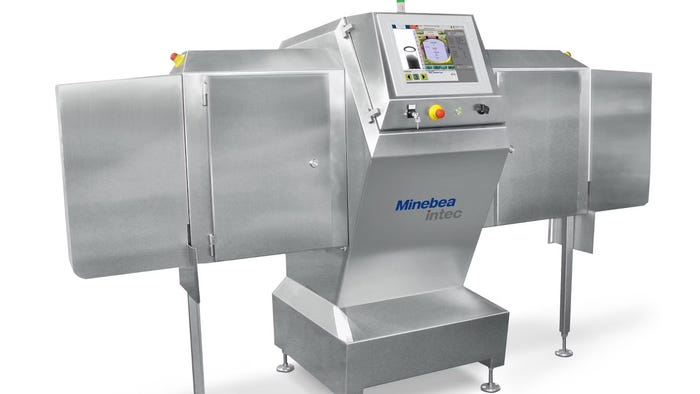The Evolution of Bucket ElevatorsThe Evolution of Bucket Elevators
A well-designed bucket elevator can significantly boost productivity, maintain product integrity, and help control operational costs.
February 18, 2025
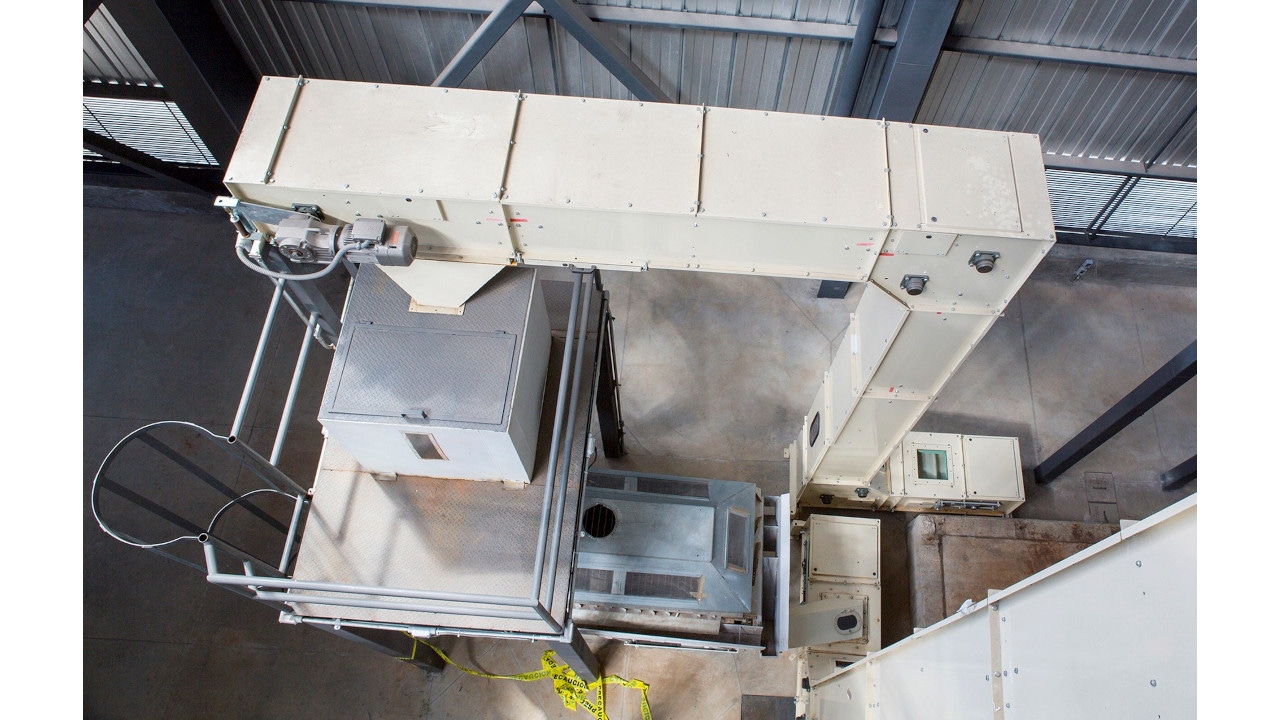
Bucket elevators have come a long way from their earlier designs, transforming into highly reliable and efficient systems that optimize vertical and horizontal bulk material movement. Their ability to transport large volumes within a minimal footprint makes them indispensable across industries such as food and beverage, agriculture, chemicals, and mining.
Unlike older models that suffered from frequent downtime and spillage, contemporary bucket elevators integrate overlapping buckets, enclosed frameworks, and heavy-duty components to extend operational lifespans while improving efficiency and cleanliness.
For organizations aiming to streamline operations, a well-designed bucket elevator can significantly boost productivity, maintain product integrity, and help control operational costs. Selecting the right materials, implementing preventive maintenance, and providing thorough operator training are all key to ensuring continuous performance and maximizing return on investment.
The Essential Role of Bucket Elevators
In modern industrial settings, efficient bulk material handling is more critical than ever. Companies transporting grains, seeds, chemicals, or other bulk products often struggle to balance throughput, facility constraints, and product integrity. Bucket elevators address these challenges by offering controlled, high-capacity vertical conveying solutions. Advances in engineering and materials have elevated them from simple mechanical devices to indispensable, highly reliable assets in production lines worldwide.
Traditionally, bucket elevators have been the workhorses of manufacturing and processing plants, particularly where products need to be moved across multiple floors or into storage bins. Unlike flat belt conveyors that take up considerable floor space, bucket elevators maximize efficiency by utilizing vertical or inclined pathways. As industry demands evolve, modern operations require solutions that provide gentle handling for fragile materials, minimal downtime to maintain efficiency, and strict compliance with safety and sanitation regulations. The latest bucket elevator designs meet these needs through enhanced durability, precision engineering, and improved material flow paths.
Challenges of Traditional Bucket Elevators
Older bucket elevator models often fall short in demanding environments, leading to frequent downtime due to worn-out chains and bearings, excessive spillage from misaligned buckets, as well as contamination and safety risks from unsealed constructions. These inefficiencies can result in lost product, increased labor costs, and potential compliance issues in regulated industries. Additionally, integrating legacy systems into modern production lines is challenging, requiring costly retrofitting and customization.
Another major issue is the availability of replacement parts, especially for elevators sourced from foreign manufacturers with limited local support. Some buckets could also be constructed of lesser quality components that can break, or chip over time. When parts are unavailable, facilities face extended downtime, further disrupting operations. These challenges underscore the need for more reliable, adaptable, and easily maintainable solutions.
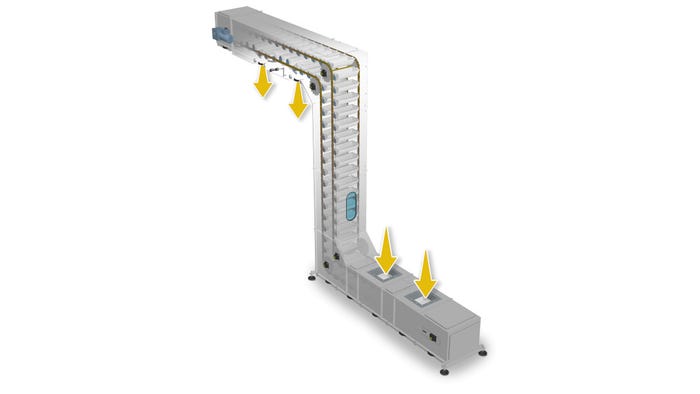
Modern bucket elevators can easily be configured to all multiple entry and or discharge points (Ryson International Inc.)
Modern Innovations in Bucket Elevator Design
Today’s bucket elevators incorporate significant advancements to address the shortcomings of earlier models. These innovations not only improve efficiency but also enhance durability, safety, and ease of maintenance.
Overlapping Buckets and Enclosed Construction
One of the most impactful improvements is the adoption of overlapping bucket designs, which create a tighter seal to prevent spillage. Additionally, fully enclosed frames minimize dust emissions and protect materials from external contamination, ensuring a cleaner and safer workspace.
Modular Frameworks for Greater Flexibility
Modern bucket elevators feature modular construction, allowing for vertical, horizontal, or angled configurations in a single system. This flexibility conserves floor space and enables integration into complex production lines with multiple inlets and discharge points. The modularity also allows the unit to be easily reconfigured for changing demands, futureproofing your conveying investment. By reducing the number of required conveyors, modular designs help lower integration complexity, energy consumption, and overall footprint.
Heavy-Duty Construction for Longevity
Contemporary bucket elevators are built for durability, utilizing high-grade chains, bearings, and structural materials to withstand 24/7 operations. In high-volume production environments, unexpected stoppages can be costly, making robust construction essential for minimizing downtime and maintaining productivity.
Ease of Maintenance and Cleaning
While durability is crucial, efficient maintenance plays an equally vital role in operational reliability. Modern bucket elevators are designed with maintenance-friendly features, including:
Removable inspection covers for quick access
External bearings for simplified lubrication
Easy-to-clean hatches for residue removal
Automatic tensioning systems to reduce mechanical strain
These enhancements streamline maintenance tasks, extend equipment lifespan, and help facilities sustain continuous throughput.
Variable Frequency Drives (VFDs) for Enhanced Control
The integration of VFDs allows for precise control over speed and torque, which is particularly useful for handling products with varying weights or fragility. Smooth acceleration and deceleration reduce mechanical stress, extending the longevity of chains and buckets while optimizing performance.
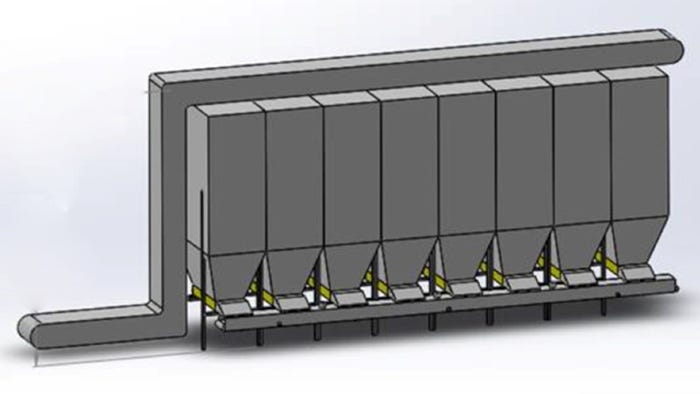
Bucket elevators can help save valuable floorspace by using a single unit to feed multiple process points or production lines (Ryson International Inc.)
Maximizing Reliability Through Maintenance
A high-performance bucket elevator is only as effective as the maintenance strategy behind it. A proactive approach to inspections and upkeep ensures long-term reliability. Key best practices include:
Regular Inspections: Detect early signs of misalignment, chain wear, or bearing degradation before they cause major failures.
Monitoring Performance Indicators: Track throughput rates, downtime incidents, and part replacements to identify trends and address issues proactively.
Predictive Maintenance: Utilize sensors to measure chain tension and motor performance, providing real-time alerts for potential problems.
Facilities that implement these strategies experience fewer unexpected breakdowns and get the most value out of their investment.
Industry Applications of Bucket Elevators
Bucket elevators remain vital across numerous industries due to their ability to handle a wide range of materials. Some of the most common applications include:
Food Processing: Transporting grains, sugar, and snack products while maintaining cleanliness and quality.
Agriculture: Elevating seeds, feed, and fertilizers while adhering to strict safety regulations.
Pharmaceuticals and Personal Care: Moving raw ingredients and finished products with minimal risk of contamination.
Chemicals and Plastics: Handling powders, flakes, and pellets in enclosed systems that prevent hazardous dust exposure.
Mining and Minerals: Conveying bulk ores and abrasive materials while minimizing equipment wear.
Recycling Processes: Transporting excess materials for disposal or recirculation within production lines.
The adaptability of bucket elevators—ranging from adjustable speeds to multiple discharge points—makes them an essential solution for efficient bulk material handling across diverse industries.
Best Practices for Implementation
For facilities considering a new bucket elevator or an upgrade, a thorough assessment of material characteristics, throughput requirements, and facility constraints is essential. Early collaboration with equipment specialists can help tailor solutions that accommodate factors such as high temperatures, chemical resistance, and specialized handling needs.
Operator training is another critical component of successful implementation. Even the most advanced bucket elevator can underperform if improperly used. Investing in comprehensive staff training on system operations, maintenance protocols, and troubleshooting techniques can significantly reduce downtime and extend the equipment’s lifespan.
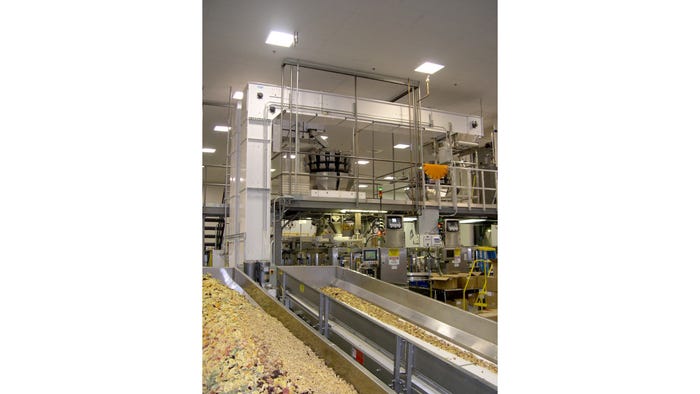
The bucket elevator’s modular design can help reduce your operational footprint (Ryson International Inc.)
The Future of Bucket Elevators
The next generation of bucket elevators will likely integrate advanced automation and digital monitoring. IoT-enabled systems are already emerging, offering real-time insights into motor health, bucket alignment, and chain tension. These predictive maintenance capabilities help minimize downtime and improve efficiency.
Material advancements are also shaping the future of bucket elevators. Research into composite components and specialized alloys is leading to buckets with enhanced durability for extreme environments, including high-heat, metal detectable and corrosive applications. The goal is to create even more resilient, low-maintenance systems that adapt to evolving industry needs.
Conclusion: Investing in Quality Over Cost
Modern bucket elevators have shed the inefficiencies of their predecessors, becoming essential tools for high-efficiency bulk material handling. With overlapping bucket designs, enclosed structures, modular flexibility, and VFD-driven precision, these systems offer superior throughput, gentle product handling, and long-term reliability.
However, the lowest-cost option is not always the best investment. Some manufacturers offer bargain-priced systems manufactured overseas, which may lack post-sale support, training, and readily available replacement parts. For businesses looking to minimize long-term costs, selecting a bucket elevator from a reputable manufacturer with local support ensures better performance, reduced downtime, and a lower total cost of ownership.
Investing in high-quality machinery often proves more cost-effective over time compared to less expensive alternatives. While the initial purchase price may be higher, the total cost of ownership can be significantly lower due to reduced downtime, greater reliability, lower maintenance needs, and improved energy efficiency. For example, high-quality equipment can reduce unplanned downtime by up to 30%, directly boosting productivity and minimizing revenue loss from halted operations. Additionally, maintenance costs can be 25-40% lower due to durable components and fewer repair needs. Energy-efficient machinery can cut power consumption costs by 15-20%, adding substantial savings over the machine’s lifespan. When these factors are combined, businesses can see up to 50% savings in total cost of ownership compared to less expensive alternative. In essence, a higher upfront investment translates into long-term operational efficiency, cost savings, and business growth.
By prioritizing quality and support, companies can leverage bucket elevators as a reliable backbone of their material handling strategy—enhancing productivity while keeping operational costs in check. A company with a long-standing history of customer support, and long-lasting quality, in the long run, is your best bet.
Bill Keane is a bucket elevator specialist Ryson International Inc. (Yorktown, VA). For more information, call 757-898-1530 or visit ryson.com.
About the Author
You May Also Like


